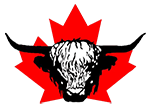Highland Cattle originated in the Highlands and west coastal islands of Scotland, areas severe in climate and lashed by the North Atlantic gales. Throughout the long recorded history of Highlands, breeders have taken great care to retain the original characteristics of these cattle. Originally, the breed was divided into two classes, the West Highlands or Kyloe, and the Highlander.
The Kyloes, raised on the western islands of Scotland, tended to be of a smaller size and had a higher percentage of black and brindled cattle than the mainland Highlanders. The size difference was probably due more to the severe climate and limited rations that the island cattle were subjected to than to any genetic variation between the classes. Today all members of the breed are called Highland.
The Highland Cattle Society of Scotland was established in 1884 and the first Herd Book published in 1885.
History of Canadian Highland Cattle
Highland Cattle were first imported into Canada from Scotland in the 1880s: one bull by the Hon. Donald A. Smith (Lord Strathcona), Winnipeg, and one bull by Robert Campbell, Strathclair, Manitoba, who later also imported five females. History has also recorded the presence of Highland Cattle in Nova Scotia during these early years.
The late 1920s began the era significant to present day Canadian breeders, when importations were made from Scotland by breeders in Saskatchewan and Ontario. R. Home Smith of Toronto imported one female and W.A. McInroy of Ilderton, Ontario, imported two females and a male in 1928. In 1929, Mary Lindsay imported six females and one male to Greenstreet, Saskatchewan, and later that year R. Home Smith imported four more females and one male.
Since that time there have been many more importations, some of which were on a much larger scale of between 10-40 animals. In the early 1950's importing and exporting of Highland Cattle started between Canada and the United States.
The Canadian Highland Cattle Society was formally incorporated as a livestock breed association under the Livestock Pedigree Act in October 1964. From that time to the present, the Canadian Highland Cattle Society has employed the services of Canadian Livestock Records Corporation to verify and record the pedigrees of all registered Canadian Highland Cattle.
All Highlands registered in the Canadian Herd Book must be purebred. By not allowing the addition of other breeds to the Canadian Highland gene pool, the Canadian Highland Cattle Society maintains the purity of the race.
Canadian cattle have always had an excellent health record. This factor, along with the present worldwide demand for Highland Cattle, has led to a number of exports of Canadian Highlands and Highland embryos to countries such as Australia, New Zealand, Denmark, Germany and even Scotland.



